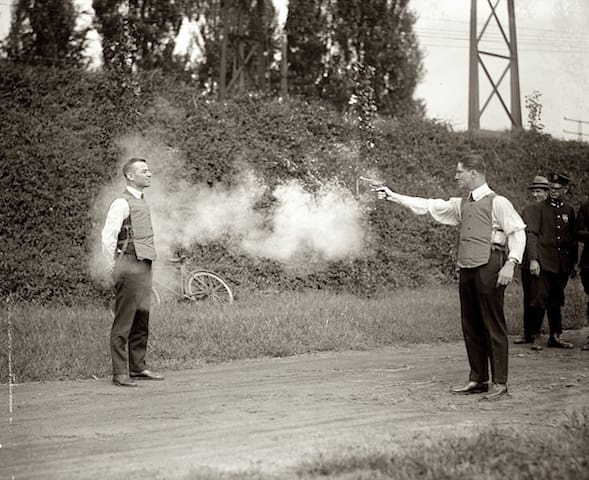We see a lot of bulletproof vests on television – and damned if they don’t always stop the bullet perfectly. Well, they have to work on TV because they are plot devices.
Oh no! Crockett shot Tubbs! How can this be? Oh, I get it. Ricardo was wearing a bulletproof vest under that tailored Italian suit.
I just started looking through the wikipedia entry about bulletproof, or bullet-resistant, body armor. It seems that people started designing bulletproof armor not long after they started using bullets. Flash forward to the Twentieth Century, and the increase in personal firepower seems to be a result of effective soft armor worn by criminals during Prohibition.
During the late 1920s through the early 1930s, gunmen from criminal gangs in the United States began wearing less-expensive vests made from thick layers of cotton padding and cloth. These early vests could absorb the impact of handgun rounds such as .22 Long Rifle, .25 ACP, .32 S&W Long, .32 S&W, .380 ACP, and .45 ACP traveling at speeds of up to 300 m/s (980 ft/s). To overcome these vests, law enforcement agents such as the FBI began using the newer and more powerful .38 Super, and later the .357 Magnum cartridge.
Granted the above information is from wikipedia, but it certainly complicates the “stopping power” arguments I have read elsewhere, because it implies that these lower calibers stopped opponents well enough before they wore bullet-resistant clothing. When I first heard about the .357 Magnum in popular culture, back in the 70s, it was supposed be a powerful handgun that could stop criminals in automobiles. Wikipedia corroborates that – but says that the vests were a prime factor, as well as competing with the Super.
Do criminals breaking into a house often wear expensive body armor? I have to wonder if I need a weapon with high-velocity, high-pressure ammo to defeat vests that relatively few people will be wearing.
I also wonder if owning a vest would be worthwhile. They seem to range in cost about the same as good quality guns, meaning from $300 to as much as you have to spend, but they are somewhat specific as to what sorts of weapons and ammo they can deter. For example, some aren’t much use against knives.
And while I’d be allowed to wear a bullet-resistant vest in the city, I wouldn’t want to wear one on a crowded train on a hot day. Also, while Stana Katic looks good in her vest, they are rather bulky.
Tactically I could see a vest as being more useful than a concealed weapon against someone who fires at you from behind, or otherwise takes you by surprise, which is the rule here in the city. But after the first shot you’d have to either run away fast (sweating in your vest) or return fire – which brings us back to concealed carry.





Unless part of your job involves putting yourself in harms way I can't imagine why you'd want to spend good money on a vest.
Better to spend it at the gym getting in shape or learning martial arts or something more useful.
Also if your neighborhood is so rough you're contemplating body armor, better to spend that money on a security deposit for an apartment in a nicer area.
A guy was killed while picking up Chinese food in East Baltimore.
http://wjz.com/local/carryout.shooting.man.2.1619…
And last week another East Baltimore man was killed while sitting in his Comcast truck.
http://wjz.com/local/botched.robbery.homicide.2.1…
I live in West Baltimore, but not that far away from some rough areas.
Comments are closed.